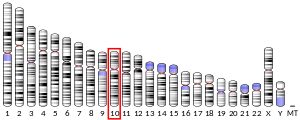Tachykinin receptor 2
Substance-K receptor is a protein that in humans is encoded by the TACR2 gene.[5]
Function
This gene belongs to a family of genes that function as receptors for tachykinins. Receptor affinities are specified by variations in the 5'-end of the sequence. The receptors belonging to this family are characterized by interactions with G proteins and 7 hydrophobic transmembrane regions. This gene encodes the receptor for the tachykinin neuropeptide substance K, also referred to as neurokinin A.[5]
Selective Ligands
Several selective ligands for NK2 are now available, and although most of the compounds developed so far are peptides, one small-molecule antagonist Saredutant is currently in clinical trials as an anxiolytic and antidepressant.
Agonists
- GR-64349 - potent and selective agonist, EC50 3.7nM, 7-amino acid polypeptide chain. CAS# 137593-52-3
Antagonists
- Ibodutant
- Saredutant
- GR-159,897
- MEN-10376 - potent and selective antagonist, 7-amino acid polypeptide chain. CAS# 135306-85-3
See also
References
- GRCh38: Ensembl release 89: ENSG00000075073 - Ensembl, May 2017
- GRCm38: Ensembl release 89: ENSMUSG00000020081 - Ensembl, May 2017
- "Human PubMed Reference:". National Center for Biotechnology Information, U.S. National Library of Medicine.
- "Mouse PubMed Reference:". National Center for Biotechnology Information, U.S. National Library of Medicine.
- "Entrez Gene: TACR2 tachykinin receptor 2".
Further reading
- Maggi CA, Giuliani S, Patacchini R, Santicioli P, Theodorsson E, Barbanti G, Turini D, Giachetti A (Jan 1992). "Tachykinin antagonists inhibit nerve-mediated contractions in the circular muscle of the human ileum. Involvement of neurokinin-2 receptors". Gastroenterology. 102 (1): 88–96. PMID 1370160.
- Gerard NP, Gerard C (1991). "Molecular cloning of the human neurokinin-2 receptor cDNA by polymerase chain reaction and isolation of the gene". Annals of the New York Academy of Sciences. 632: 389–90. doi:10.1111/j.1749-6632.1991.tb33132.x. PMID 1659296.
- Cyr C, South V, Saltzman A, Felder S, Ricca GA, Jaye M, Huebner K, Kagan J, Croce CM, Schlessinger J (1991). "Cloning, expression of the human substance K receptor, and analysis of its role in mitogenesis". Annals of the New York Academy of Sciences. 632: 426–7. doi:10.1111/j.1749-6632.1991.tb33144.x. PMID 1659297.
- Morten JE, Hopkins B, Powell SJ, Graham A (Dec 1991). "Human NK-2 receptor gene maps to chromosome region 10q11-21". Human Genetics. 88 (2): 200–3. doi:10.1007/bf00206072. PMID 1661704.
- Graham A, Hopkins B, Powell SJ, Danks P, Briggs I (May 1991). "Isolation and characterisation of the human lung NK-2 receptor gene using rapid amplification of cDNA ends". Biochemical and Biophysical Research Communications. 177 (1): 8–16. doi:10.1016/0006-291X(91)91940-E. PMID 1710456.
- Gerard NP, Eddy RL, Shows TB, Gerard C (Jan 1991). "The human neurokinin A (substance K) receptor. Molecular cloning of the gene, chromosome localization, and isolation of the cDNA from tracheal and gastric tissues". The Journal of Biological Chemistry. 266 (2): 1354. PMID 1845990.
- Kris RM, South V, Saltzman A, Felder S, Ricca GA, Jaye M, Huebner K, Kagan J, Croce CM, Schlessinger J (Jan 1991). "Cloning and expression of the human substance K receptor and analysis of its role in mitogenesis". Cell Growth & Differentiation. 2 (1): 15–22. PMID 1848773.
- Gerard NP, Eddy RL, Shows TB, Gerard C (Nov 1990). "The human neurokinin A (substance K) receptor. Molecular cloning of the gene, chromosome localization, and isolation of cDNA from tracheal and gastric tissues". The Journal of Biological Chemistry. 265 (33): 20455–62. PMID 2173708.
- Alblas J, van Etten I, Khanum A, Moolenaar WH (Apr 1995). "C-terminal truncation of the neurokinin-2 receptor causes enhanced and sustained agonist-induced signaling. Role of receptor phosphorylation in signal attenuation". The Journal of Biological Chemistry. 270 (15): 8944–51. doi:10.1074/jbc.270.15.8944. PMID 7721803.
- Bhogal N, Donnelly D, Findlay JB (Nov 1994). "The ligand binding site of the neurokinin 2 receptor. Site-directed mutagenesis and identification of neurokinin A binding residues in the human neurokinin 2 receptor". The Journal of Biological Chemistry. 269 (44): 27269–74. PMID 7961636.
- Arkinstall S, Emergy I, Church D, Chollet A, Kawashima E (Jan 1994). "Calcium influx and protein kinase C alpha activation mediate arachidonic acid mobilization by the human NK-2 receptor expressed in Chinese hamster ovary cells". FEBS Letters. 338 (1): 75–80. doi:10.1016/0014-5793(94)80119-3. PMID 8307161.
- Brunelleschi S, Bordin G, Colangelo D, Viano I (Jun 1998). "Tachykinin receptors on human monocytes: their involvement in rheumatoid arthritis". Neuropeptides. 32 (3): 215–23. doi:10.1016/S0143-4179(98)90040-3. PMID 10189055.
- Patacchini R, Giuliani S, Turini A, Navarra G, Maggi CA (Jun 2000). "Effect of nepadutant at tachykinin NK(2) receptors in human intestine and urinary bladder". European Journal of Pharmacology. 398 (3): 389–97. doi:10.1016/S0014-2999(00)00346-0. PMID 10862829.
- Bellucci F, Carini F, Catalani C, Cucchi P, Lecci A, Meini S, Patacchini R, Quartara L, Ricci R, Tramontana M, Giuliani S, Maggi CA (Jan 2002). "Pharmacological profile of the novel mammalian tachykinin, hemokinin 1". British Journal of Pharmacology. 135 (1): 266–74. doi:10.1038/sj.bjp.0704443. PMC 1573107. PMID 11786503.
- Patacchini R, Barbagli G, Palminteri E, Lazzeri M, Turini D, Maggi CA (Mar 2002). "Tachykinin NK1 and NK2 receptors mediate inhibitory vs excitatory motor responses in human isolated corpus cavernosum and spongiosum". British Journal of Pharmacology. 135 (6): 1351–4. doi:10.1038/sj.bjp.0704650. PMC 1573278. PMID 11906947.
- Candenas ML, Cintado CG, Pennefather JN, Pereda MT, Loizaga JM, Maggi CA, Pinto FM (Dec 2002). "Identification of a tachykinin NK(2) receptor splice variant and its expression in human and rat tissues". Life Sciences. 72 (3): 269–77. doi:10.1016/S0024-3205(02)02240-3. PMID 12427486.
- Bandari PS, Qian J, Oh HS, Potian JA, Yehia G, Harrison JS, Rameshwar P (May 2003). "Crosstalk between neurokinin receptors is relevant to hematopoietic regulation: cloning and characterization of neurokinin-2 promoter". Journal of Neuroimmunology. 138 (1–2): 65–75. doi:10.1016/S0165-5728(03)00096-1. PMID 12742655.
- Zhao A, Shea-Donohue T (Oct 2003). "PAR-2 agonists induce contraction of murine small intestine through neurokinin receptors". American Journal of Physiology. Gastrointestinal and Liver Physiology. 285 (4): G696-703. doi:10.1152/ajpgi.00064.2003. PMID 12801882.
External links
- "Tachykinin Receptors: NK2". IUPHAR Database of Receptors and Ion Channels. International Union of Basic and Clinical Pharmacology.
This article incorporates text from the United States National Library of Medicine, which is in the public domain.




